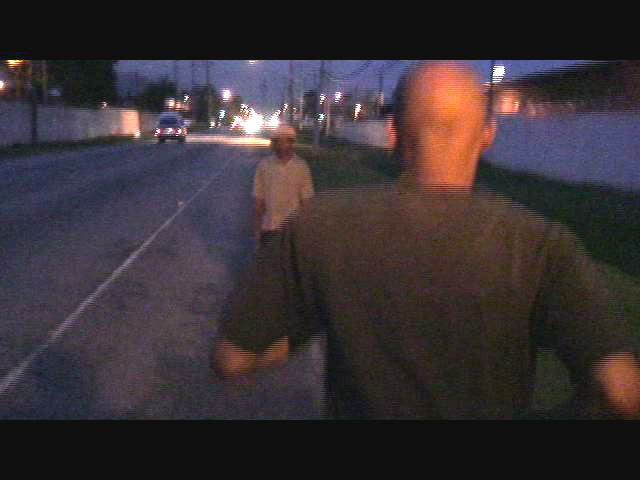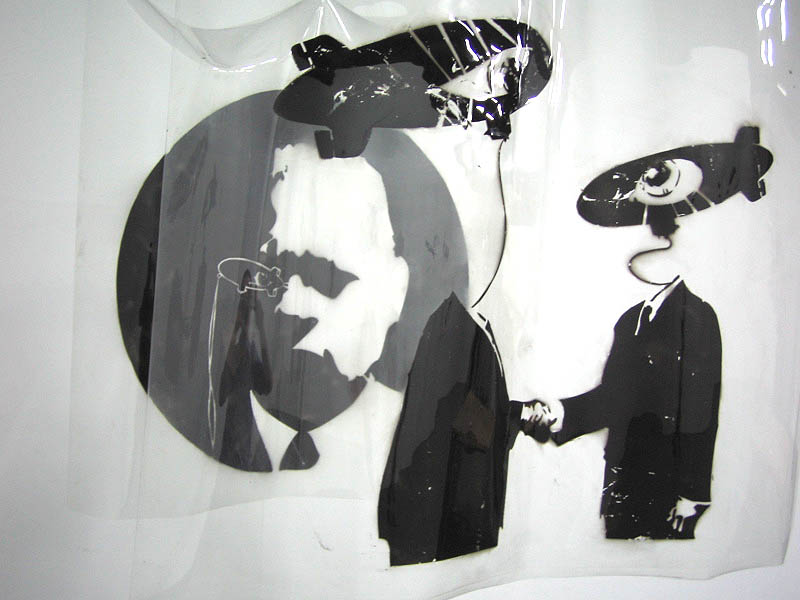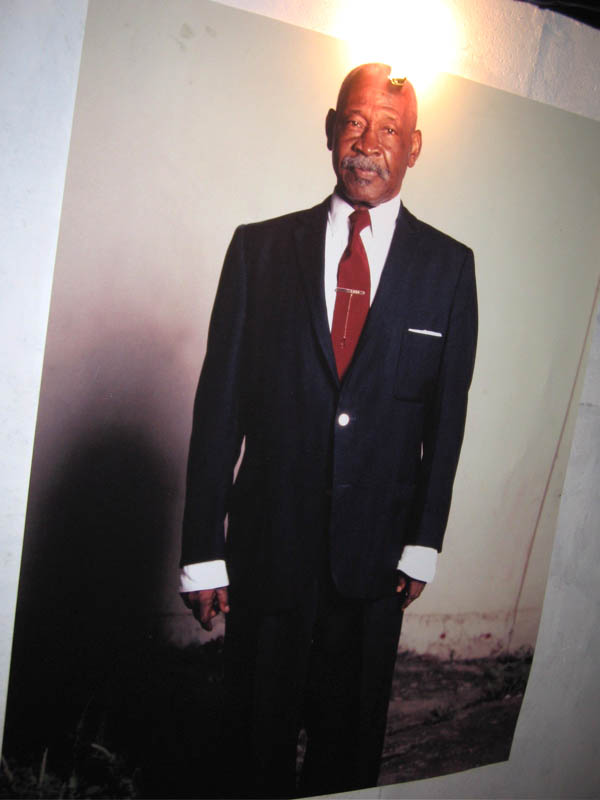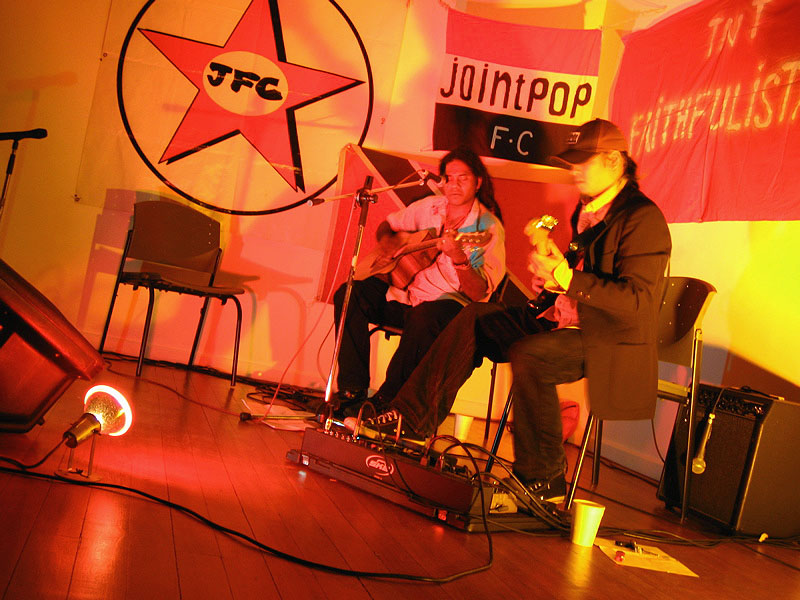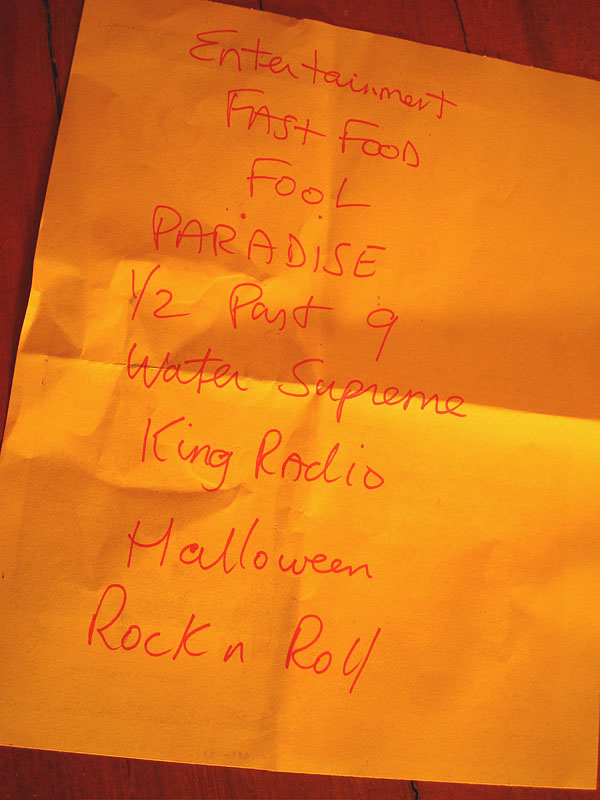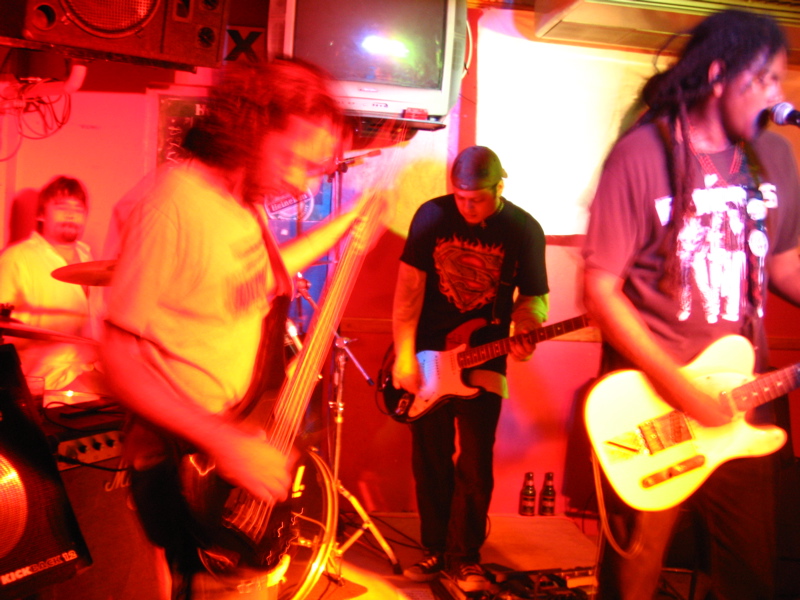"Make a space": Galvanize in the Trinidad and Tobago Review
The following dialogue between Christopher Cozier and Nicholas Laughlin appears in the November 2006 Trinidad and Tobago Review
"What is 'Caribbean' art? ... What should it look like, sound like, feel like? Who decides? Who is paying attention? Is the work of contemporary artists in Trinidad and Tobago really registering with an audience? Where? When? How? Or are these artists 'visibly absent', there-but-not-there, eluded by a meaningful critical response, invisible to conventional expectations of what Caribbean art practice should be?"
-- From the brief statement in the Galvanize leaflet distributed at all events
Nicholas Laughlin: We began Galvanize with questions, and the sense that this whole initiative was an experiment. We emphasised the improvisatory, the spontaneous, the investigative. True, this was partly from necessity -- the whole thing was pulled together with limited resources and often volunteer effort. We were sort of making it up as we went along. As Steve Ouditt and others have suggested, there's a way in which Galvanize was (or is) not a series of events, or an engine for producing artworks, but a kind of collective work in itself, with all the participants as co-creators.
Christopher Cozier: This is how I have always seen contemporary art practice in this country, since the early 80s. At best, the practice could be a reflection of the type of democracy we live in, or ask questions about the prospect of real democracy as a space of possibility: which ideas are allowed, who gets to speak, and under what kinds of circumstances? Who has permission?
For me, the failure or success of Galvanize as a creative process will be determined by what kinds of conversations we will be having next year, and the following.
NL: I suppose the timing -- Galvanize opened a week before Carifesta -- made it inevitable that people would see it as a fringe event. But we tried to make it clear from the beginning that this was an independent effort driven by urgencies with no direct connection to Carifesta. I was fascinated by the reactions of some of the cultural authorities within the Carifesta machine.
"I don't know what Galvanize is about. Even if Galvanize was something of significance within the art world, that is also our arts. In a kind of way, Carifesta has given us the occasion, the focus, and countless peoples in the communities. They can’t be compared. One is a Caribbean festival. Galvanize is a Trinidadian -- and not even a full Trinidad [festival]. What tells us Galvanize represents Trinidad and Tobago?"
— Earl Lovelace, Carifesta IX artistic director, in an interview with B.C. Pires, Sunday Express, 24 September, 2006
"When we don't establish a kind of structure or continuity you have a breakaway almost renegade attitude," he said, making reference to the ongoing Galvanize project initiated by a group of young artists.
He says the project excludes the opinions of the elders and so little can be learnt from its participants....
"We are growing up without mentors because we have trained our minds to be renegades, so we rebel against anything."
— Leroy Clarke, quoted in a feature by Michael Mondezie headlined "At home with the master artist", Sunday Express, 15 October, 2006
CC: You just said it -- they are playing out their roles as "cultural authorities". I know this sounds like a line from Valentino's "Life Is a Stage". Are they continuously marking out a territorial space, like a game of pitch? So they made their ring in the dirt, and their pockets are bulging with marbles. For generations we have been silently watching their game. Perhaps the era in which they grew up created that need to assert and defend that space. But there is a big enough patch of dirt. If they want to continue playing for bokey over there -- fine. Perhaps we want to play Three Hole or Long Dab instead. Maybe current generations are playing Grand Theft Auto and Sim City, and don't want to get their brands muddy.
But when did pursuing an initiative on one's own, rather than just talking and talking, or waiting around on others for handouts, become rebellion?
Galvanize is a modest endeavour that is, for now, looking outwards from Port of Spain. Carifesta was based on the Georgetown conversations in the early 70s, and was an attempt at regional cultural integration regionally, since new flags were going up.
NL: The theme of Galvanize 2006 was "visibly absent", a phrase invented by Peter Doig to describe the contemporary art scene in Trinidad -- it applies as well to musicians, writers, and others -- artists who are very present and hard at work, but somehow not registering with local audiences, local "cultural authorities", the local marketplace. Galvanize tried to create a platform for these "emerging" artists, a space where they could engage with unconventional audiences in unconventional ways.
We took the art out of the gallery space and put it in public locations -- in the Savannah, on walls around town, in a tattoo parlour, the entrance to a dancehall. Conversely, we brought a band that usually plays in dark, smoky bars into a gallery at CCA, and another to a Woodbrook backyard. We asked newspaper columnists to discuss whether their writing could be "literature".
"One of the main problems regarding the audience for contemporary art in Trinidad is the perception that contemporary art is in a hierarchy above other creative production. This myth is supported by the way institutions create a type of inclusion/exclusion of ideas to facilitate their own agendas, therefore retarding the free movement of ideas and criticisms. More importantly, the artists become resentful and lack the confidence to produce. If we dispel this myth, we will see more art production emanating in some very unusual places. When I was in Cuba I was invited to artists' projects in people's living rooms (eg Espacio Aglutinador), on the streets, in hospitals, etc. I believe it is organic by nature."
-- Mario Lewis
NL: I like the distinction you made early on: that we were not grabbing a space -- which implies taking it from someone else -- but making our own.
CC: We are not an emerging or developing culture or context. This is not a little game of catch-up with an allegedly more developed circumstance. To think like that would be to think like Columbus, in the tradition of those scamps throughout our history who arrived here and said there is nothing. Nothing for who?
We are merely moving along with our business as practitioners. The space exists. Artists have been doing the work and building the dialogue, but expectations on the part of the public and local experts have not responded at the same rate. We are doing our thing -- it is not made real by who happens to feel like looking for the moment.
See Galvanize, then, as simply underscoring the fact that there is a history and dialogue and context to which we responding. Where did CCA come from, what created that need? To what questions is it responding, and why? And, by extension, why have Galvanize now?
I was excited to see a new generation of people getting the kind of support and encouragement I did not have when my practice became more investigative and thus ambitious.
NL: "Conversation" has been a key term in Galvanize -- the idea that it's useful to pay attention to each other, for artists to enter into dialogues with each other, artists with writers, musicians with architects, everyone with their audiences. No soapboxes or bestowing of titles like "master artist", but a real curiosity about the work.
CC: In terms of my own practice and the entire contemporary scene, I feel "conversation" is a key word. It looks beyond cultural pedagogy. It's about listening and sharing. The real subject of Galvanize is the collaboration and mutual support among the participants, the process. People came and participated. That is something more than the "nothing" everyone gets well rewarded for advocating.
By the time this text is published, there will have been five thousand visits to the Galvanize website?
NL: From thirty or forty countries at least. The conversation is also happening through our web presence -- the Galvanize blog and Flickr set -- which makes the initiative visible to a much bigger international audience. We used these online tools for expediency in the first place, but we've broken some interesting ground. The UK Guardian ran a story the other week suggesting that curators might soon be using Flickr's image-hosting service to curate online exhibitions. We've already done that.
CC: For contemporary Trinidadian artists, ideas and exchanges are happening on a much larger international platform. Artists from Trinidad are showing and giving lectures in New York, Oslo, South Africa, Japan, Brazil, London, and so on. It's not even news anymore. It's just what they do as professionals. We are simply moving along in that larger historical conversation.
Read entire post
"What is 'Caribbean' art? ... What should it look like, sound like, feel like? Who decides? Who is paying attention? Is the work of contemporary artists in Trinidad and Tobago really registering with an audience? Where? When? How? Or are these artists 'visibly absent', there-but-not-there, eluded by a meaningful critical response, invisible to conventional expectations of what Caribbean art practice should be?"
-- From the brief statement in the Galvanize leaflet distributed at all events
Nicholas Laughlin: We began Galvanize with questions, and the sense that this whole initiative was an experiment. We emphasised the improvisatory, the spontaneous, the investigative. True, this was partly from necessity -- the whole thing was pulled together with limited resources and often volunteer effort. We were sort of making it up as we went along. As Steve Ouditt and others have suggested, there's a way in which Galvanize was (or is) not a series of events, or an engine for producing artworks, but a kind of collective work in itself, with all the participants as co-creators.
Christopher Cozier: This is how I have always seen contemporary art practice in this country, since the early 80s. At best, the practice could be a reflection of the type of democracy we live in, or ask questions about the prospect of real democracy as a space of possibility: which ideas are allowed, who gets to speak, and under what kinds of circumstances? Who has permission?
For me, the failure or success of Galvanize as a creative process will be determined by what kinds of conversations we will be having next year, and the following.
NL: I suppose the timing -- Galvanize opened a week before Carifesta -- made it inevitable that people would see it as a fringe event. But we tried to make it clear from the beginning that this was an independent effort driven by urgencies with no direct connection to Carifesta. I was fascinated by the reactions of some of the cultural authorities within the Carifesta machine.
"I don't know what Galvanize is about. Even if Galvanize was something of significance within the art world, that is also our arts. In a kind of way, Carifesta has given us the occasion, the focus, and countless peoples in the communities. They can’t be compared. One is a Caribbean festival. Galvanize is a Trinidadian -- and not even a full Trinidad [festival]. What tells us Galvanize represents Trinidad and Tobago?"
— Earl Lovelace, Carifesta IX artistic director, in an interview with B.C. Pires, Sunday Express, 24 September, 2006
"When we don't establish a kind of structure or continuity you have a breakaway almost renegade attitude," he said, making reference to the ongoing Galvanize project initiated by a group of young artists.
He says the project excludes the opinions of the elders and so little can be learnt from its participants....
"We are growing up without mentors because we have trained our minds to be renegades, so we rebel against anything."
— Leroy Clarke, quoted in a feature by Michael Mondezie headlined "At home with the master artist", Sunday Express, 15 October, 2006
CC: You just said it -- they are playing out their roles as "cultural authorities". I know this sounds like a line from Valentino's "Life Is a Stage". Are they continuously marking out a territorial space, like a game of pitch? So they made their ring in the dirt, and their pockets are bulging with marbles. For generations we have been silently watching their game. Perhaps the era in which they grew up created that need to assert and defend that space. But there is a big enough patch of dirt. If they want to continue playing for bokey over there -- fine. Perhaps we want to play Three Hole or Long Dab instead. Maybe current generations are playing Grand Theft Auto and Sim City, and don't want to get their brands muddy.
But when did pursuing an initiative on one's own, rather than just talking and talking, or waiting around on others for handouts, become rebellion?
Galvanize is a modest endeavour that is, for now, looking outwards from Port of Spain. Carifesta was based on the Georgetown conversations in the early 70s, and was an attempt at regional cultural integration regionally, since new flags were going up.
NL: The theme of Galvanize 2006 was "visibly absent", a phrase invented by Peter Doig to describe the contemporary art scene in Trinidad -- it applies as well to musicians, writers, and others -- artists who are very present and hard at work, but somehow not registering with local audiences, local "cultural authorities", the local marketplace. Galvanize tried to create a platform for these "emerging" artists, a space where they could engage with unconventional audiences in unconventional ways.
We took the art out of the gallery space and put it in public locations -- in the Savannah, on walls around town, in a tattoo parlour, the entrance to a dancehall. Conversely, we brought a band that usually plays in dark, smoky bars into a gallery at CCA, and another to a Woodbrook backyard. We asked newspaper columnists to discuss whether their writing could be "literature".
"One of the main problems regarding the audience for contemporary art in Trinidad is the perception that contemporary art is in a hierarchy above other creative production. This myth is supported by the way institutions create a type of inclusion/exclusion of ideas to facilitate their own agendas, therefore retarding the free movement of ideas and criticisms. More importantly, the artists become resentful and lack the confidence to produce. If we dispel this myth, we will see more art production emanating in some very unusual places. When I was in Cuba I was invited to artists' projects in people's living rooms (eg Espacio Aglutinador), on the streets, in hospitals, etc. I believe it is organic by nature."
-- Mario Lewis
NL: I like the distinction you made early on: that we were not grabbing a space -- which implies taking it from someone else -- but making our own.
CC: We are not an emerging or developing culture or context. This is not a little game of catch-up with an allegedly more developed circumstance. To think like that would be to think like Columbus, in the tradition of those scamps throughout our history who arrived here and said there is nothing. Nothing for who?
We are merely moving along with our business as practitioners. The space exists. Artists have been doing the work and building the dialogue, but expectations on the part of the public and local experts have not responded at the same rate. We are doing our thing -- it is not made real by who happens to feel like looking for the moment.
See Galvanize, then, as simply underscoring the fact that there is a history and dialogue and context to which we responding. Where did CCA come from, what created that need? To what questions is it responding, and why? And, by extension, why have Galvanize now?
I was excited to see a new generation of people getting the kind of support and encouragement I did not have when my practice became more investigative and thus ambitious.
NL: "Conversation" has been a key term in Galvanize -- the idea that it's useful to pay attention to each other, for artists to enter into dialogues with each other, artists with writers, musicians with architects, everyone with their audiences. No soapboxes or bestowing of titles like "master artist", but a real curiosity about the work.
CC: In terms of my own practice and the entire contemporary scene, I feel "conversation" is a key word. It looks beyond cultural pedagogy. It's about listening and sharing. The real subject of Galvanize is the collaboration and mutual support among the participants, the process. People came and participated. That is something more than the "nothing" everyone gets well rewarded for advocating.
By the time this text is published, there will have been five thousand visits to the Galvanize website?
NL: From thirty or forty countries at least. The conversation is also happening through our web presence -- the Galvanize blog and Flickr set -- which makes the initiative visible to a much bigger international audience. We used these online tools for expediency in the first place, but we've broken some interesting ground. The UK Guardian ran a story the other week suggesting that curators might soon be using Flickr's image-hosting service to curate online exhibitions. We've already done that.
CC: For contemporary Trinidadian artists, ideas and exchanges are happening on a much larger international platform. Artists from Trinidad are showing and giving lectures in New York, Oslo, South Africa, Japan, Brazil, London, and so on. It's not even news anymore. It's just what they do as professionals. We are simply moving along in that larger historical conversation.
Read entire post

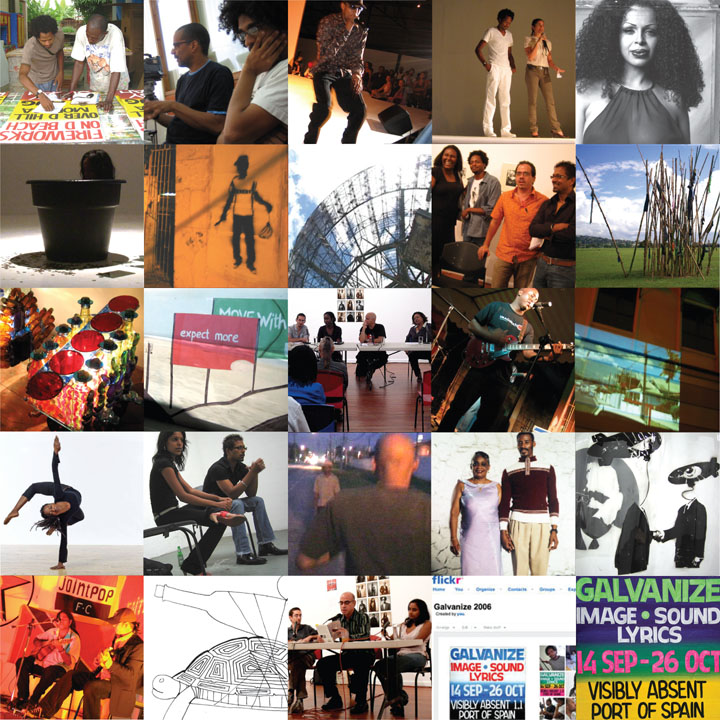
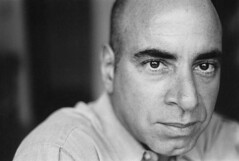
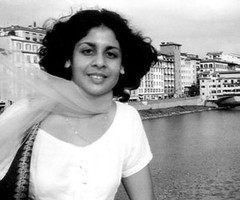
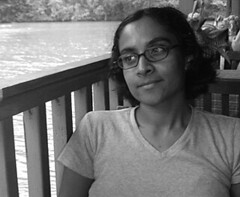
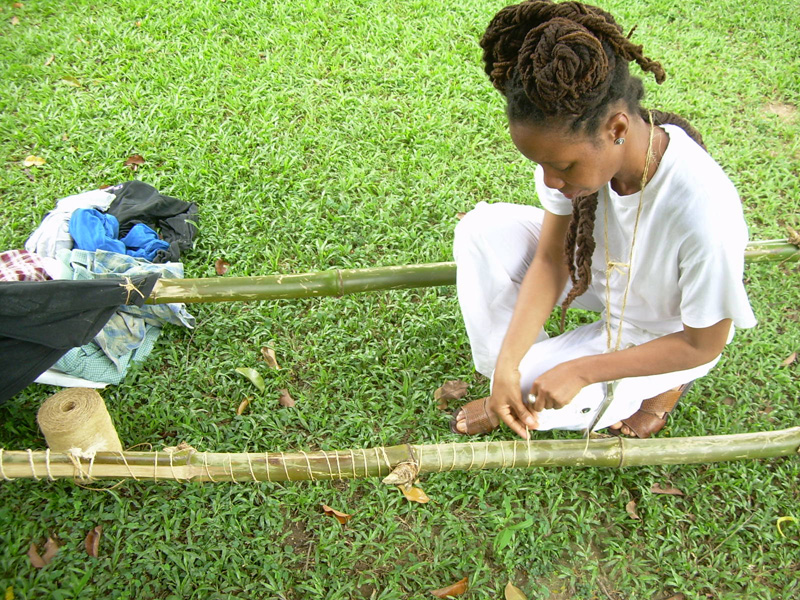
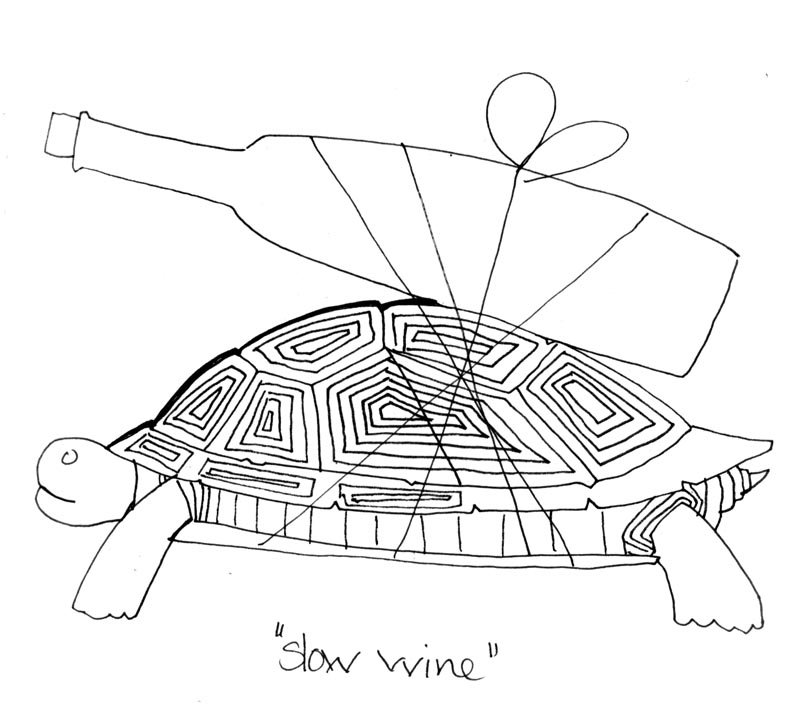
![illya furlonge-walker [lyndersay]](http://static.flickr.com/93/271198700_92f01d336e_m.jpg)
